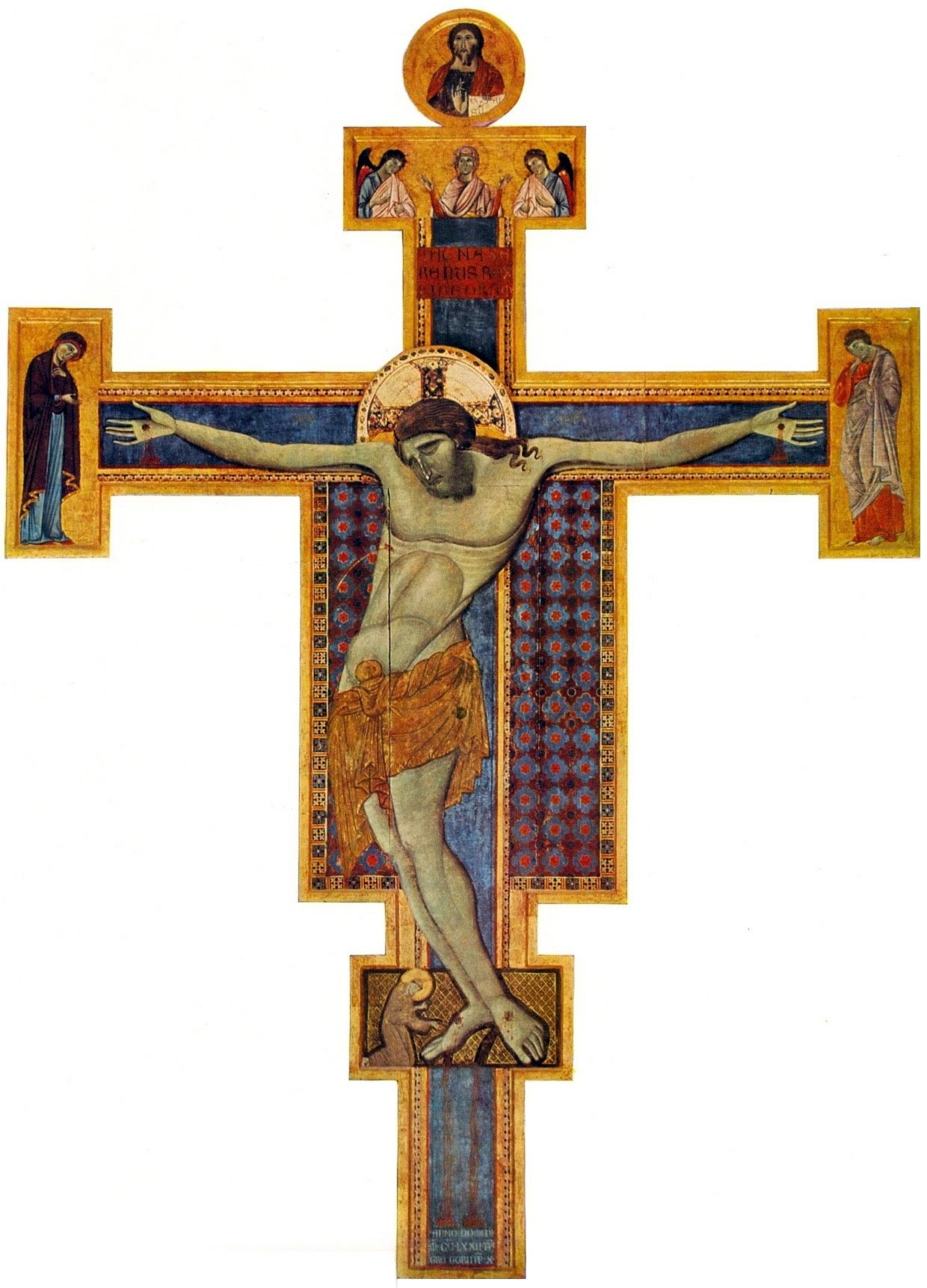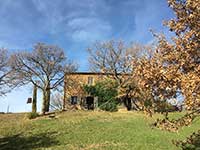| |
|
 |
 |

|
| |
Maestro di San Francesco, 1272, tempera e oro su tavola, 410 × 328 cm, Galleria nazionale dell'Umbria, Perugia [1]
|
|
![Toacana ] Galleria di immagini](../../titels/albump.gif) |
|
| |
 |
|
|
| |
|
The Crucifix of Perugia by the Master of San Francesco, Galleria nazionale dell'Umbria, Perugia
|
|
|
|
| |
|
Below is the inscription "ANNO DOMINI MCCLXXII TEMPORE GREGORI P.P.X.
|
| The Crucifix of Perugia is a shaped cross painted in tempera and gold on wood (410 x328 cm) attributed to the Master of San Francesco, dated 1272 and kept in the National Gallery of Umbria in Perugia. This monumental Crucifix with St Francis kneeling at Christ's feet is the only dated work of the Master of St Francis. It was painted for San Francesco al Prato, Perugia in conjunction with a double-sided altarpiece. The church collapsed in 1317.
The National Gallery of Umbria preserves the largest collection of Umbrian art and some of the most significant works of art in central Italy, from the 13th to the 19th century.
The Crucifix of Perugia is one of the few attributed in agreement with the Maestro di San Francesco, an Umbrian painter trained at Giunta Pisano's workshop and active in the construction site of the Basilica of San Francesco in Assisi, in which, in particular in the nave of the lower basilica, remains one of his fragmentary fresco cycle.
Like the Crucifix of Castiglion Fiorentino, the representation of the painted Cross, takes up the typology of the Christus Patiens, of Byzantine inspiration, where the pain and death of Jesus are underlined by the head reclined on the shoulder and the arch of the body [3].
The Crucifix of Perugia
Regarding the crucifix, the first reference to the Master of St. Francis is by Thode (1885), generally accepted by all subsequent critics. This is a type of representation that is particularly frequent in Umbria in the thirteenth century, linked to the spread of Franciscanism, promoter of such images in which the devotee could reflect on the human sufferings of Christ, and probably also linked to practical factors, such as the scarcity of laboratories goldsmithery in the region, which made the artifacts of painting particularly in demand.
|
|
| Maestro di San Francesco, 1272, details of the Crucifix of Perugiai, Galleria nazionale dell'Umbria, Perugia [2] |
Descrizione e stile
Enzo Carli: 'Here, the harsh dramatic tension of Giunta’s treatment has changed to a gentler one through flowing linear rhythms that impart a stately decorative effect to the deeply curved body of the Christ. Giunta’s bronze-like skin tones have been replaced by softly shaded tones of light and delicate hue. Among other things, the figures of the sorrowing Madonna and Saint John in the capricroce are full length, replacing do usual busts, and a tiny figure of Saint Francis kneels at Christ’s feet. Despite a grandiose layout, the Perugia crucifix is a work of highly refined elegance and is not lacking in graphic facility. The painting of Saint Francis follows the tendency to the verge of the grotesque. The saints minuscule face perches over the exaggerated length of his body; the once stiff cassock is loosely draped it in supple folds' [4].
|

|
Crocifisso, Maestro di San Francesco, 1272, Galleria nazionale dell'Umbria, Perugia (2)
|
|
|
|
| |
|
Il Maestro di San Francesco
|
|
|
 |
|
 |
|
 |
Maestro di San Francesco, 1272, tempera e oro su tavola, 410 × 328 cm, Galleria nazionale dell'Umbria, Perugia
|
|
Maestro di San Francesco, 1272, particolare del, Galleria nazionale dell'Umbria, Perugia
|
|
Maestro di San Francesco, 1272, particolare del volto, Galleria nazionale dell'Umbria, Perugia |
Maestro di San Francesco
This painter of frescoes and panels and, perhaps, designer of stained glass in the district around Perugia was named by Thode after a panel of St Francis with Angels in S Maria degli Angeli, Assisi. Much of the work attributed to him was part of the early phase in the decoration of S Francesco, Assisi, and includes the fresco cycle in the nave of the Lower Church with five scenes from the Passion on the right wall and five scenes from the Life of St Francis on the left. (These were damaged by the later opening of the side chapels.) In spite of the obvious participation of assistants, the entire cycle seems to have been planned by a single artist and can be considered as homogeneous and characteristic of his style. This was largely based on the later works of Giunta Pisano but also shows the influence of such Umbrian artists as Rainaldetto di Ranuccio, Simeone and Machilone and of contemporary manuscript illumination, for example the Gospel Book of Giovanni da Gaibena (Padua, Biblioteca Capitolare). The Master of St Francis embodies an important aspect of the contact between Italian and Byzantine art of this period: Byzantine elements, particularly of iconography, are found with western forms of ornamentation and a use of colour that is far from Byzantine.
Album Maestro di San Francesco
|

|
|
|
|
|
Grande croce del Maestro di San Francesco, Chiesa di San Francesco Arezzo
|
|
|
|
|
 |
|
 |
|
 |
Dettagli del Grande croce del Maestro di San Francesco, Chiesa di San Francesco Arezzo.
Nelle tabelle alle estremità dei bracci orizzontali sono rappresentati la Madonna e san Giovanni dolenti [1].
|
|
|
| |
|
 |
|
|
|
|
[1] Foto Pubblico dominio.
[2] MASTER of St Francis (active c. 1260-1280 in Umbria) | www.wga.hu
[3] Fonte: Emanuele, La Croce dipinta in Umbria al tempo di Giunta e Giotto, tra eleganze dolorose e coinvolgimento emotivo.
hoofd, In: Francesco e la croce dipinta p. 69-102, Cinisello Balsamo (Milano) (2016).
[4] Enzo Carli, Italian Primitives: Panel Painting of the Twelfth and Thirteenth Centuries, Abrams, New York, 1965, p. 40.
|
| |
|
|
|
|
Bibliography
Marco Pierini, Due schede sul Maestro di San Francesco, in Francesco e la croce dipinta, catalogo della mostra (Perugia, Galleria Nazionale dell'Umbria, 30 ottobre 2016-29 gennaio 2017), a cura di Marco Pierini, Silvana Editoriale, Cinisello Balsamo 2016, pp. 104-119.
Marco Pierini (Siena 1966) ha conseguito la laurea e il dottorato di ricerca in Estetica all’Università degli Studi di Siena. È stato direttore, a partire dal 2002, del Centro Arte Contemporanea di Siena, prima ospitato al Palazzo delle Papesse e dal giugno 2008 al Santa Maria della Scala col nome di SMS Contemporanea. Dal 1 ottobre 2015 è direttore della Galleria Nazionale dell’Umbria di Perugia e Direttore del Polo Museale dell’Umbria.
Nicoletta Matteuzzi, Affreschi agiografici iconico-narrativi in Toscana (1320-1490), Universitą degli studi di Firenze, Firenze, 2013
Isabella Droandi, Per la pittura del Duecento nell’Aretino, in “ARTE IN TERRA D’AREZZO. IL MEDIOEVO” a cura di Marco Collareta e Paola Refice, Firenze 2010, pp. 181-206
Elvio Lunghi, Il Crocefisso di Giunta Pisano e l'icona del Maestro di San Francesco alla Porziuncola, Assisi 1995. ISBN 8827003002
Enio Sindona, Cimabue e il momento figurativo pregiottesco, Rizzoli Editore, Milano, 1975.
|

Art in Tuscany | Master of Saint Francis
|

“Se ti senti stanco di te stesso e hai bisogno di ritrovare te stesso, lavarti dei dubbi, non c’è posto migliore della Toscana d’autunno” [ORIANA FALLACI].
Turismo e vacanze in Toscana | Podere Santa Pia | Residenze per artisti
|
| |
|
|
 |
|
|
|
|
Casa vacanze
|
|
Podere Santa Pia |
|
Colline sotto Podere Santa Pia
|
 |
Podere Santa Pia è un casolare interamente in pietra, è posto in posizione estremamente panoramica con ampia vista sulla Maremma Grossetana
|
|
|
| |
|
|
|
| |
|
|
|
| |
|
|
|
| |
|
|
|
| |
|
|
|
| |
|
|
|

